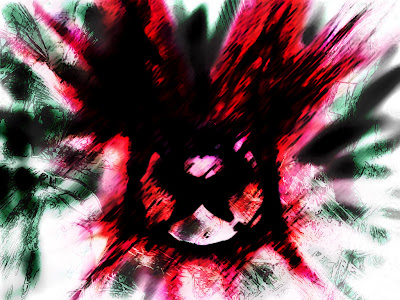 While on the train, I was viewing my pictures for something to do for a long, Internet-less, two hours. I figured that the butterfly photo I had was rather a bland look, so I took it into my own hands. I used my photo shop program as well as a little illustrator (bare in mind, this was at the point where I thought that I was going to fail that course because I had no idea how to use photo shop or illustrator), and twisted the picture to my own. The reason I renamed it the SCOURGE OF A BUTTERFLY, is if we think of a butterfly as just a butterfly, this frail and almost insignificant animal, then we are obviously forgetting about one of the most famous theories of all, the butterfly effect. The butterfly in the picture is meant to be the imprint of a butterfly that had been stepped on and flattened on the ground, the action burned into the ground (ground zero for the beginning of the long, ALMOST random domino effect). The ring around the butterfly is the ever expending and ever widening reach, burning and affecting everything that comes into the wake. The green and white scarring was meant to represent the scarring that is happening as the effect reaches further. Essentially, I wanted to make it seem to spread the message that the butterfly effect does indeed exist and although it may not seem to be in any way related to the initial event, it may actually be part of a bigger picture. As it was said in Heroes as Peter and his mother were talking, "Step on a butterfly and 10, 000 people may end up dead".
While on the train, I was viewing my pictures for something to do for a long, Internet-less, two hours. I figured that the butterfly photo I had was rather a bland look, so I took it into my own hands. I used my photo shop program as well as a little illustrator (bare in mind, this was at the point where I thought that I was going to fail that course because I had no idea how to use photo shop or illustrator), and twisted the picture to my own. The reason I renamed it the SCOURGE OF A BUTTERFLY, is if we think of a butterfly as just a butterfly, this frail and almost insignificant animal, then we are obviously forgetting about one of the most famous theories of all, the butterfly effect. The butterfly in the picture is meant to be the imprint of a butterfly that had been stepped on and flattened on the ground, the action burned into the ground (ground zero for the beginning of the long, ALMOST random domino effect). The ring around the butterfly is the ever expending and ever widening reach, burning and affecting everything that comes into the wake. The green and white scarring was meant to represent the scarring that is happening as the effect reaches further. Essentially, I wanted to make it seem to spread the message that the butterfly effect does indeed exist and although it may not seem to be in any way related to the initial event, it may actually be part of a bigger picture. As it was said in Heroes as Peter and his mother were talking, "Step on a butterfly and 10, 000 people may end up dead".FOR THOSE WHO WANT TO SEE A REALLY GOOD MOVIE BASED ON THE BUTTERFLY EFFECT,
(A.K.A. - CHAOS THEORY, DOMINO EFFECT, ETC....), RENT THE MOVIE "CHAOS".
